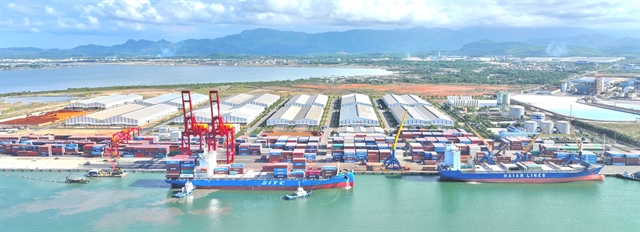The Government has indicated it will increase infrastructure spending in 2025, and hopes are high that this and other measures will also make consumers more confident about increasing spending.

HCM CITY — Domestic factors, including a ramp-up in Government infrastructure spending, a revival of the real estate market and a recovery in consumer spending, will help Việt Nam sustain GDP growth of around 6.5 per cent next year, Michael Kokalari, chief economist at VinaCapital, has said in his recent “Looking ahead at 2025” report.
Exports to the US and foreign tourist arrivals surged this year, but the growth of both was set to slow dramatically next year, he said.
Exports to the US rose by well over 20 per cent this year (versus a 10 per cent drop in 2023), the main factor supporting 2024 GDP growth.
That was driven by a 40 per cent jump in exports of electronics and other high-tech products.
“However, we expect the extraordinary increase in exports to the US to moderate next year partly because the US economy is likely headed for a ‘soft landing’.”
Additional reasons to expect slower export growth next year were related to the US inventory re-stocking cycle, while exports across Asia were currently boosted by “pull-forward” demand in the lead-up to Trump taking office – which would lead to lower demand next year. Consequently Việt Nam’s manufacturing output growth would likely drop next year, since most products produced here were sold to overseas customers.
“We do not expect Việt Nam’s exports and/or manufacturing output to actually shrink next year because a steady inflow of FDI ensures that more factories begin producing (and exporting) products in Việt Nam every year.
“Also, despite the expected slowdown in manufacturing output growth next year, we expect Việt Nam to achieve 6.5 per cent GDP growth in 2025 because we expect the composition of the growth to transition to more domestically driven factors next year.”
Local consumer research firms such as Cimigo and InFocus Mekong Research had said weak sentiment among consumers weighed on economic growth in 2023 and 2024, but has improved somewhat in 2024.
Consumer spending recovery
Real retail sales growth (stripping out the impact of inflation) was around 6 per cent in 2024, below the 8-9 per cent typical rate.
Furthermore, some half of that 6 per cent was attributable to the continued rise in foreign tourist numbers from 70 per cent of pre-COVID levels in 2023 to 100 per cent in 2024.
Consumption accounted for over 60 per cent of the economy (versus 25 per cent for manufacturing), and so higher consumption growth would easily compensate for slower growth in exports/manufacturing/tourist arrivals next year.

The Government had indicated it would increase infrastructure spending in 2025, and hopes were high that this and other measures would also make consumers more confident about increasing spending.
“We anticipate a pickup in consumer spending next year [also] for a different reason: we expect Việt Nam’s Government to take significant steps to unfreeze the real estate market.
“We believe that a recovering real estate market would have a far greater impact on both consumer sentiment than increased infrastructure spending.”
A modest increase in infrastructure spending, which accounted for 6 per cent of GDP, would not be sufficient to significantly boost the economy.
However, a combination of faster progress on works like the Long Thành International Airport and Hà Nội’s new ring roads and a real estate market revival would probably make consumers feel more confident to spend money because of the “wealth effect” linked to the value of properties that many middle-class people owned.
Long-term GDP growth
The national assembly had set a 2025 GDP growth target of 6.5-7 per cent, and Government officials recently announced multiple measures to boost the economy, including increased infrastructure spending and serious structural reforms.
These measures would certainly boost long-term GDP growth but might not be sufficient to offset slower export growth next year, which meant more drastic measures could be required to meet growth targets.
It was possible that 2025 would be somewhat volatile for the economy and stock market.
“In the first half of 2025, falling export growth will likely deal a bigger blow to GDP growth than many economists expect.
“That dip would probably prompt aggressive Government actions to support the economy, especially in light of the very ambitious GDP growth targets.
“The net result could be subdued growth at the beginning of 2025, followed by a strong acceleration towards the end.”
“We see minimal risk that [US President Donald] Trump’s tariff policies will derail Việt Nam’s growing economy – in sharp contrast to claims published in some newspaper articles since his election – but Việt Nam has the third largest trade surplus with the US.
“Việt Nam will need to take urgent steps to reduce its trade surplus with the US to avoid being targeted by Trump at some point.”
The VN-Index was up 12.1 per cent for the year as of 18 December, despite record selling by foreign investors, which was partly prompted by a near 5 per cent fall in the value of the dong.
“The resilience of Việt Nam’s stock market despite nearly US$4 billion of net foreign selling, coupled with a very attractive valuation (12x forward P/E versus about 17 per cent expected EPS growth) means that the VNI would not need much of a catalyst to continue climbing next year.” — VNS





